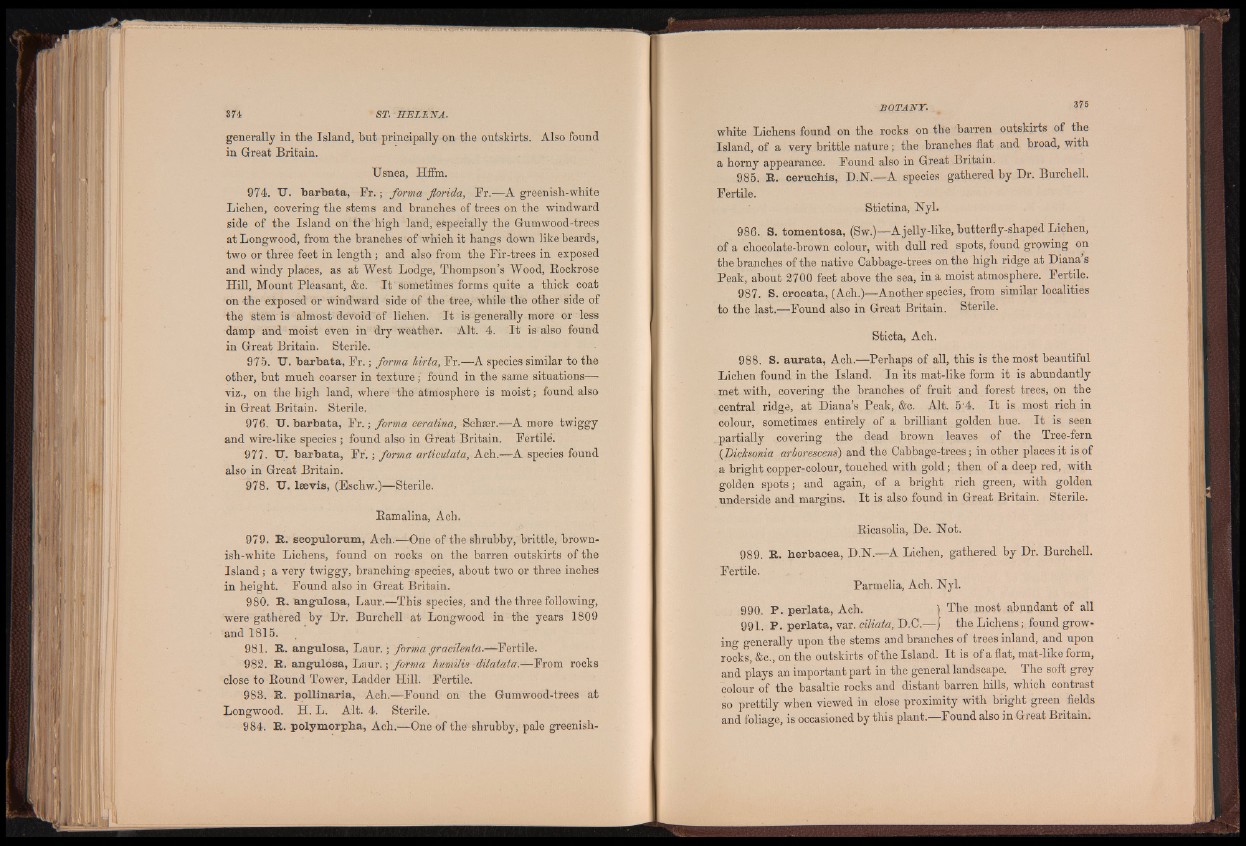
generally in the Island, but principally on the outskirts. Also found
in Great Britain.
Usnea, Hffm.
974. TT. barb ata, F r .; forma florida, Fr.—A greenish-white
Lichen, covering the stems and branches of trees on the windward
side of the Island on the high land, especially the Gum wood-trees
atLongwood, from the branches of which it hangs down like beards,
two or three feet in length ; and also from the Fir-trees in exposed
and windy places, as at West Lodge, Thompson’s Wood, Bockrose
Hill, Mount Pleasant, &c. I t ' sometimes forms quite a thick coat
on the exposed or windward side of the tree, while the other side of
the stem is almost devoid of lichen. I t is generally more or less
damp and moist even in dry weather. Alt. 4. I t is also found
in Great Britain. Sterile.
975. U. barbata, F r .; forma hirta, Fr.—A species similar to the
other, hut much coarser in texture; found in the same situations—
viz., on the high land, where the atmosphere is moist; found also
in Great Britain. Sterile,
976. U. barbata, F r .; forma ceratina, Schser.—A more twiggy
and wire-like species ; found also in Great Britain. Fertile’.
977. TJ. b arb ata, F r . ; forma articulata, Ach.—A species found
also in Great Britain.
978. IT. las vis, (Eschw.)—Sterile.
Bamalina, Ach.
979. R. scopulorum, Ach.—One of the shrubby, brittle, brownish
white Lichens, found on rocks on the barren outskirts of the
Island; a very twiggy, branching species, about two or three inches
in height. Found also in Great Britain.
980. R. angulosa, Laur.—This species, and the three following,
were gathered by Dr. Burchell at Longwood in the years 1809
and 1815.
981. R. angulosa, L au r.; forma ^racilenta.—Yevtile.
982. R. angulosa, L au r.; forma humilis -dilatata.—From rocks
close to Bound Tower, Ladder Hill. Fertile.
983. R. pollinaria, Ach.—Found on the Gumwood-trees at
Longwood. H. L. Alt. 4. Sterile.
984. R. polymorpha, Ach.—One of the shrubby, pale greenishwhite
Lichens found on the rocks on the barren outskirts of the
Island, of a very brittle nature; the branches flat and broad, with
a horny appearance. Found also in Great Britain.
985. R. ceruchis, D.N.—A species gathered by Dr. Burchell.
Fertile.
Stictina, Nyl.
986. S. tomentosa, (Sw.)—A jelly-like, butterfly-shaped Lichen,
of a chocolate-brown colour, with dull red spots, found growing on
the branches of the native Oabbage-trees on the high ridge at Diana s
Peak, about 2700 feet above the sea, in a moist atmosphere. Fertile.
987. S. crocata, (Ach.)—Another species, from similar localities
to the last.—Found also in Great Britain. Sterile.
Sticta, Ach.
988. S. au rata, Ach.—Perhaps of all, this is the most beautiful
Lichen found in the Island. In its mat-like form it is abundantly
met with, covering the branches of fruit and forest trees, on the
central ridge, at Diana’s Peak, &c. Alt. 5'4. I t is most rich in
colour, sometimes entirely of a brilliant golden hue. I t is seen
partially covering the dead brown leaves of the Tree-fern
(DicMonia arborescens) and the Cabbage-trees; in other places it is of
a bright copper-colour, touched with gold; then of a deep red, with
golden spots; and again, of a bright rich green, with golden
underside and margins. I t is also found in Great Britain. Sterile.
Bicasolia, De. Not.
989. R. herbacea, D.N.—A Lichen, gathered by Dr. Burchell.
Fertile.
Parmelia, Ach. Nyl.
990. P . perlata, Ach. ) The most abundant of all
991. P. perlata, var. ciliata, D.C.—J the Lichens; found growing
generally upon the stems and branches of trees inland, and upon
rocks, &c., on the outskirts of the Island. I t is of a flat, mat-like form,
and plays an important part in the general landscape. The soft grey
colour of the basaltic rocks and distant barren hills, which contrast
so prettily when viewed in close proximity with bright green fields
and foliage, is occasioned by this plant.—Found also in Gieat Biitain.